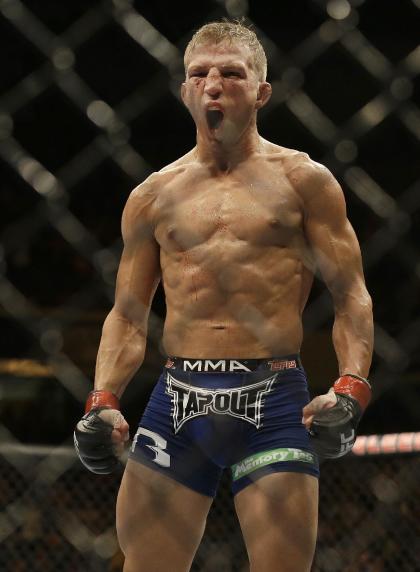How T.J. Dillashaw solved the riddle of Renan Barao
T.J. Dillashaw’s speed, movement and ability to vary his attack clearly flummoxed Renan Barao when they met in Las Vegas in the main event of UFC 173 on May 24, 2014, for Barao’s bantamweight championship.
Dillashaw’s fifth-round stoppage victory not only earned him the title, but gave him the biggest title-fight upset in UFC history.
It was a shock to many who had watched Barao’s magnificent career. He entered the fight unbeaten in more than nine years, on a 22-fight winning skein and a 33-fight unbeaten streak.
Dillashaw was so good on that night, so vastly superior, that even longtime observers were stunned.
It was a shock, though it shouldn’t have been.
The same plan that Dillashaw used to beat Barao had been on display four months earlier in Duluth, Ga., in a fight with Mike Easton.

Dillashaw, who will face Barao in a rematch for the bantamweight title on Saturday at the United Center in Chicago in the main event of a card televised nationally by Fox, had begun to study Barao in 2012 to help Team Alpha Male teammate Urijah Faber prepare for a fight with the Brazilian.
At the same time, Dillashaw worked hard on his striking with then-Team Alpha Male striking coach Thonglor “Master Thong” Armatsena.
When Duane Ludwig later was hired as Team Alpha Male’s head coach, he refined it more.
The style took advantage of Dillashaw’s quickness and agility. It was heavy on movement and creating punching angles, which could then open up his wrestling.
It worked so perfectly against Barao, it seemed as if it were something entirely new, but this was a plan a long time in the making.
“I had developed that and worked on it long before I actually fought Barao,” Dillashaw said. “It was just a matter of getting comfortable with it and using it more and more. My first striking trainer was Master Thong, and he likes a lot of movement and switching things up. But when Duane took over is when I really started to hone in on movement and angles and realizing I could fight with two different stances. I created angles a lot of people can’t because of that.
“The first time I felt fully comfortable with it, and I had fun doing it, was in the Easton fight, which turned out to be right before I fought Barao. I pulled it off and it gave me the confidence. Before I was just kind of right in front of everyone going toe-to-toe and taking a punch to give a punch. I realized that wasn’t the way to do it.”
Dillashaw was a plus-750 underdog by the time it went off, meaning few expected him to be a serious threat to Barao.
UFC president Dana White had taken to calling Barao the best pound-for-pound fighter in the world before the fight.
But one thing that White had always said resonated, particularly as Dillashaw was so cool, calm and confident leading up to the match.
For years, as he tirelessly traveled the world trying to push the UFC into the mainstream, White would laud mixed martial arts for its unpredictability.
There was, he’d say again and again to anyone who would listen, so many ways to win a fight that, quite literally, anything could happen. A fight was never over, he’d say, and even the largest underdogs had a chance.
As he’d preach that gospel, there would be eye rolls from some in his audience who dismissed it as a matter of Dana being Dana, a promoter spewing hyperbole to sell his show.
Dillashaw then went out and dominated Barao, and White didn’t look as much like a carnival barker as he did a sage.

When the fight unfolded, it was as if Dillashaw knew every move Barao would make. And, in a way, he did, having been Faber’s chief training partner when Faber was preparing for a July 21, 2012, bout against Barao.
Dillashaw would watch film of Barao, playing back sequences over and over. What he saw was a revelation: The style he was trying to develop was the perfect antidote for Barao’s explosive style.
Barao blamed a difficult weight cut for his poor performance, and indeed, struggled with his weight as he was preparing in August for a rematch. On Aug. 29, the day before he was to rematch Dillashaw at UFC 177, Barao passed out in a tub while cutting weight and was pulled from the card.
Dillashaw defeated Joe Soto, who took the title shot on 24 hours’ notice, the next night.
The UFC quickly arranged the rematch for April in Montreal, but Dillashaw broke a rib in training and it was postponed again.
The upshot is that Dillashaw began preparing for Barao more than three years ago and has never really stopped.
“He had a lot of excuses for the loss, and I get it,” Dillashaw said. “He’d been undefeated for nine years and I don’t know how many fights and I’m sure it was hard for him. He needed to create some excuse for himself so he could explain it in his own mind.
“And then he did the talking and I guess it was his way of staying relevant. But I know I whipped up on him. I know what I did.”
And he believes he’ll do it again.
No one wants to lose, particularly in a title bout, but Dillashaw has a bit of extra incentive to win. Should he lose, he’d be in line for another bout with Barao in a rubber match in the not-too-distant future.
But at some point, Dillashaw wants to move on and get past Barao. The best way to do so is to win on Saturday.
“Anybody who thinks it’s a fluke or whatever, just watch,” he said. “I’m ready for this. We’ll see if anyone feels the same way when it’s over.”
More UFC coverage:

 Yahoo Sports
Yahoo Sports 